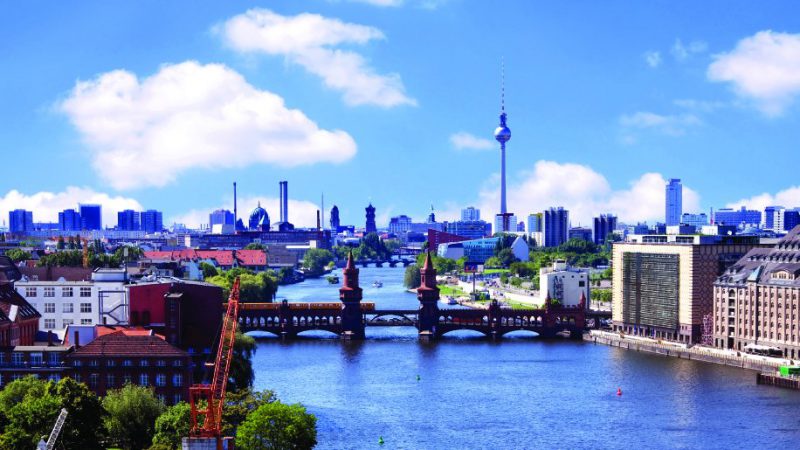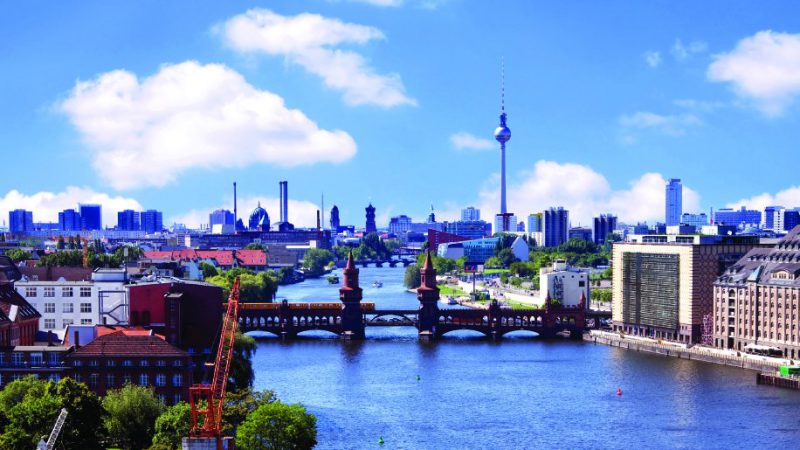4 Hours in Berlin
A meander through one of Berlin’s most compelling areas, taking in important museums, lush green spaces and cutting-edge art
March 30, 2019


Jewish Museum
Berlin’s tumultuous history is easily traceable in Kreuzberg, a large, diverse area south of the River Spree. Start at Checkpoint Charlie, the former border crossing between East and West before the Wall came down in 1989, and head towards the Jewish Museum on Lindenstrasse. Even from the outside, the Daniel Libeskind building is haunting, with its angular, zigzagging structure bringing a sense of disorientation. Inside, the story of the Jewish contribution to the city and the impact of the Holocaust, symbolized by towering empty spaces within the building’s architecture and personalized by the poignant belongings of the victims, is a stark, upsetting and very necessary reminder of this dark period of history. Open 10:00 AM – 8:00 PM daily, €8 ($9); jmberlin.de/en
Viktoriapark
For the highest natural elevation in the city with views to match, head south to Viktoriapark, a 40-acre green space on the slopes of the Tempelhof hills. This area became a park in 1894, but the extravagant Neoclassical monument at the summit dates back further still, to 1821. It was erected to celebrate a victory during the Napoleonic Wars and the cross at the top is from where Kreuzberg, which means cross hill, takes its name. Adding to the bucolic charm is an impressive manmade waterfall, modeled on one from the Krkonose mountain range on the border of Poland and the Czech Republic, a favored getaway for Berlin notables in the 19th century. The Golgatha biergarten at the foot of the park is a lovely spot for a refreshing beverage.
Curry 36
Two of Berlin’s most renowned dining options are cheap, delicious takeaway joints and near-neighbors on Mehringdamm, the wide thoroughfare that heads south out of the city. Curry 36 vends Berlin’s best-known fast food of choice, currywurst – pork sausage doused in spiced ketchup, usually with a side of fries. Mustafa’s, meanwhile, is the place to go for doner kebab, the other contender for the city’s most beloved snack on the hoof – before you curl your lip, forget the British version: according to legend, Berlin is where the Turkish-influenced dish was created in the seventies. Join the snaking queue that leads to the unassuming cabin and grab a soft pita piled high with tender grilled meat, crisp pickles and moreish sauces. curry36.de; mustafas.de
Street art
From Mehringdamm, get the U-Bahn to Gorlitzer Bahnhof. In the east of the area towards the River Spree, which separates Kreuzberg from the equally animated neighborhood of Friedrichshain, is some of the city’s best street art. Look out for the vast Astronaut Cosmonaut by French artist Victor Ash adorning the side of a building on Mariannenstrasse, which was partly inspired by David Bowie’s music. On Oranienstrasse you’ll spy a mural by Belgian artist ROA, which features animals such as a deer and a stork in reference to the fauna that once roamed the area. On a smaller, more temporary scale, and thus less liable to a hefty fine from the authorities, are intricate sticker works and other removable pieces. Guided walks are available from Alternative Berlin Tours. alternativeberlin.com
Markthalle Neun
Don’t miss the nearby Markthalle Neun. This covered market reopened in 2011 after an absence of 120 years and is home to dozens of stalls selling local and international specialties. Not only is it a way to indulge your inner glutton, but the market is also a great place to get a handle on the character of Kreuzberg (except on Sundays, when it’s closed). So, too, is the Turkish Market to the south, where you can find a taste of Istanbul, complete with haggling, on Tuesdays and Fridays. If it’s summer, carry on to Badeschiff, a floating outdoor pool on the Spree that has excellent riverside views and plenty of options for an alfresco drink.




